by Carolyn Bernhardt
February 19, 2024
For the past decade, the state of Minnesota has grappled with the relentless onslaught of the invasive emerald ash borer (EAB, Agrilus planipennis), a beetle species responsible for the demise of countless ash trees. Puny, pearlescent, and pathogen-ridden, EAB larvae burrow beneath tree bark, tunneling galleries that can extend up to 20 inches in length. These timber trespassers’ feeding frenzy weakens trees, but it also facilitates the spread of disease-causing fungi, which pose a compounded threat to the integrity of trees.
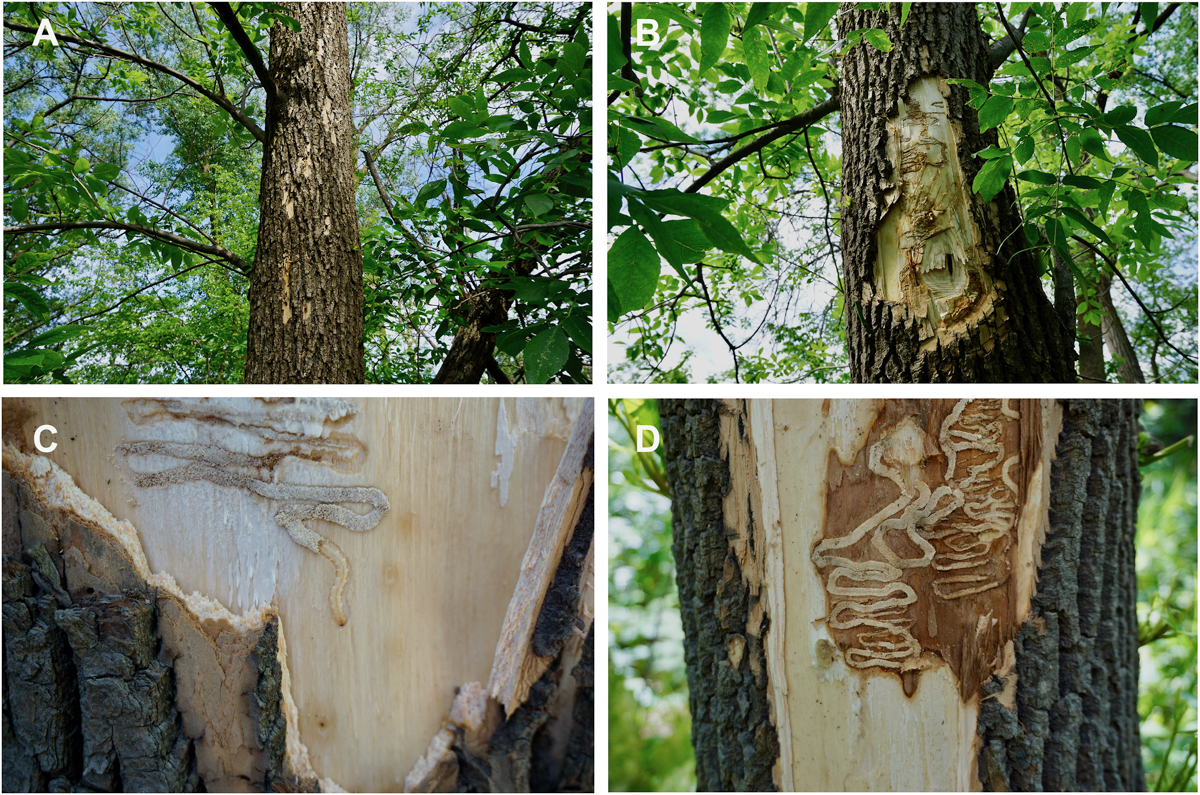
However, hope emerges among the ecological mayhem caused by these beetles and their companion fungi: some EAB-associated fungi have special traits that make them entomopathogenic, meaning they can harm or kill insects.
“Fungi are associated with many different insects,” says Robert Blanchette, PhD, a professor in the Department of Plant Pathology in the College of Food, Agricultural and Natural Resource Sciences. “As the emerald ash borer entered and expanded its range in the US, no one had looked at what fungi may be associated with it.” So, Blanchette’s lab is leading this work with funding from the Minnesota Invasive Terrestrial Pests and Plants Center.
According to Blanchette, researchers already knew that some types of insect-associated fungi can affect trees, such as canker-causing and decay-causing fungi, and some fungi can attack insects. He and his team decided it was crucial to study these fungi more closely to decipher the difference and then, one day, leverage the entomopathogenic fungi that are native to Minnesota against the beetles. If successful, this project will provide new information to validate the use of fungi as a biological control to attack EAB at the egg, larval, and adult stages.
In collaboration with the experts at the MN Department of Natural Resources, the Minnesota Department of Agriculture, the USDA-ARS Emerging Pests and Pathogens Unit, as well as the City of Minnetonka and other communities, the team is closing in on which fungal strains would work best against EAB. “We couldn’t do this meaningful work without the collaboration and support of these partners,” says Colin Peters, a graduate student in Blanchette’s lab focusing on this project.
First phase revelations
The team wrapped up the first phase of their project in 2022, after publishing three papers about their findings. In their first paper, they became the first to focus on the fungal community associated with EAB larval galleries in Minnesota. After analyzing 1,126 fungal cultures from EAB galleries, they found a total of 173 fungal taxa, with some potentially new species. Out of this plethora, three main functional guilds of fungi materialized: canker pathogens (30%), decay fungi (8%), and entomopathogens (8%). Canker-causing fungi were most abundant, likely invading areas where larvae wounded tree tissue. Decay fungi seemed to contribute to wood degradation, affecting tree strength, and entomopathogenic fungi could infect EAB larvae and adults.

Since the canker-causing fungi group was the largest, the team then focused on seven canker-causing fungi isolated from EAB-infested trees in their next paper, evaluating the canker formation that followed inoculation. They identified the top three most impactful species, deciphering the leading fungi, Diplodia mutila, which caused the largest lesions. The team noted that the identified fungi may act opportunistically, taking advantage of stressed trees attacked by EAB and causing larger lesions. “We found many different canker-causing fungi, and some are more pathogenic than others,” Blanchette says, “but with stress to the trees caused by the beetle, even the ones with a lower capacity to kill trees can cause damage.”
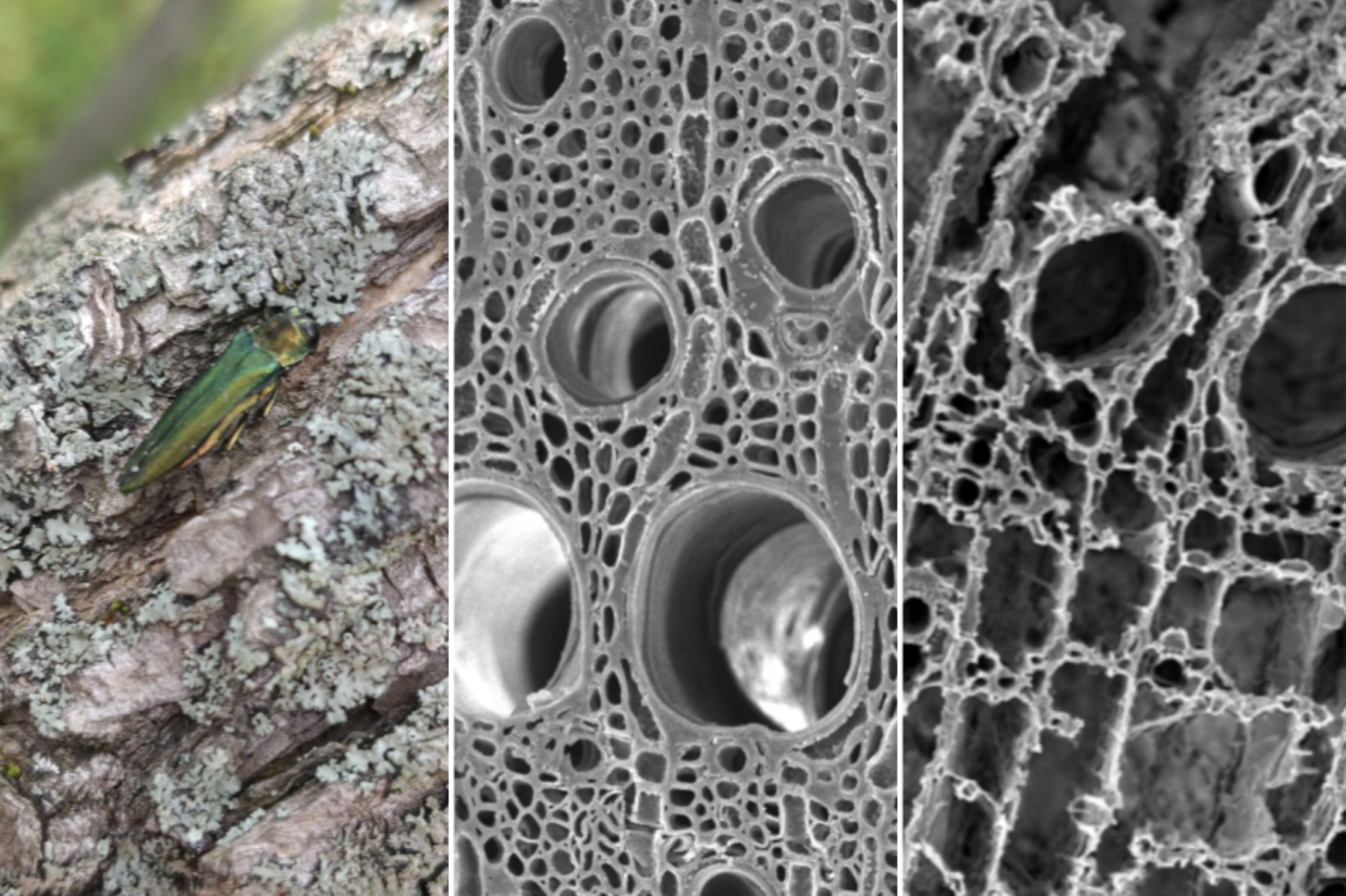
In addition to understanding the cankers some of these harmful fungi can cause, the researchers were also interested in understanding how other fungi they found cause tree decay. “We took the major species of wood decay fungi that we previously found and did a laboratory study to determine their capacity to decay wood,” says Blanchette. The scientists sterilized and inoculated ash wood blocks with 13 different strains of decay fungus. “After a time, we could determine how much biomass loss had taken place, and microscopically identify what type of decay occurred.”
The study showed that many of the isolated white-rot fungi were aggressive wood degraders. The study’s results helped rank each of the fungi's capacity to contribute to the rapid loss of wood strength in EAB-affected trees. “The decay fungi associated with EAB are very aggressive pioneer species that can colonize quickly and cause wood decay,” Blanchette explains. “As these fungi get established in trees with EAB, they destroy the wood's strength properties, making the tree very hazardous. Removing these trees early is essential to avoid tree failure and damage to property and hazards to people.”
Harnessing the power of fungi for good
While the team identified the greatest threats among the decay fungi, they also found some fungal species that can attack and kill the beetles at different life stages. This is the focus of phase 2 of this work, which began in January 2023 and will wrap up in June 2026. “We are just beginning to understand the interactions of different fungi with the beetle and the tree,” says Blanchette. “An important next step is testing the fungi we found that can kill the beetle in field trials.” That way, the team can verify which fungi are effective control measures against EAB.
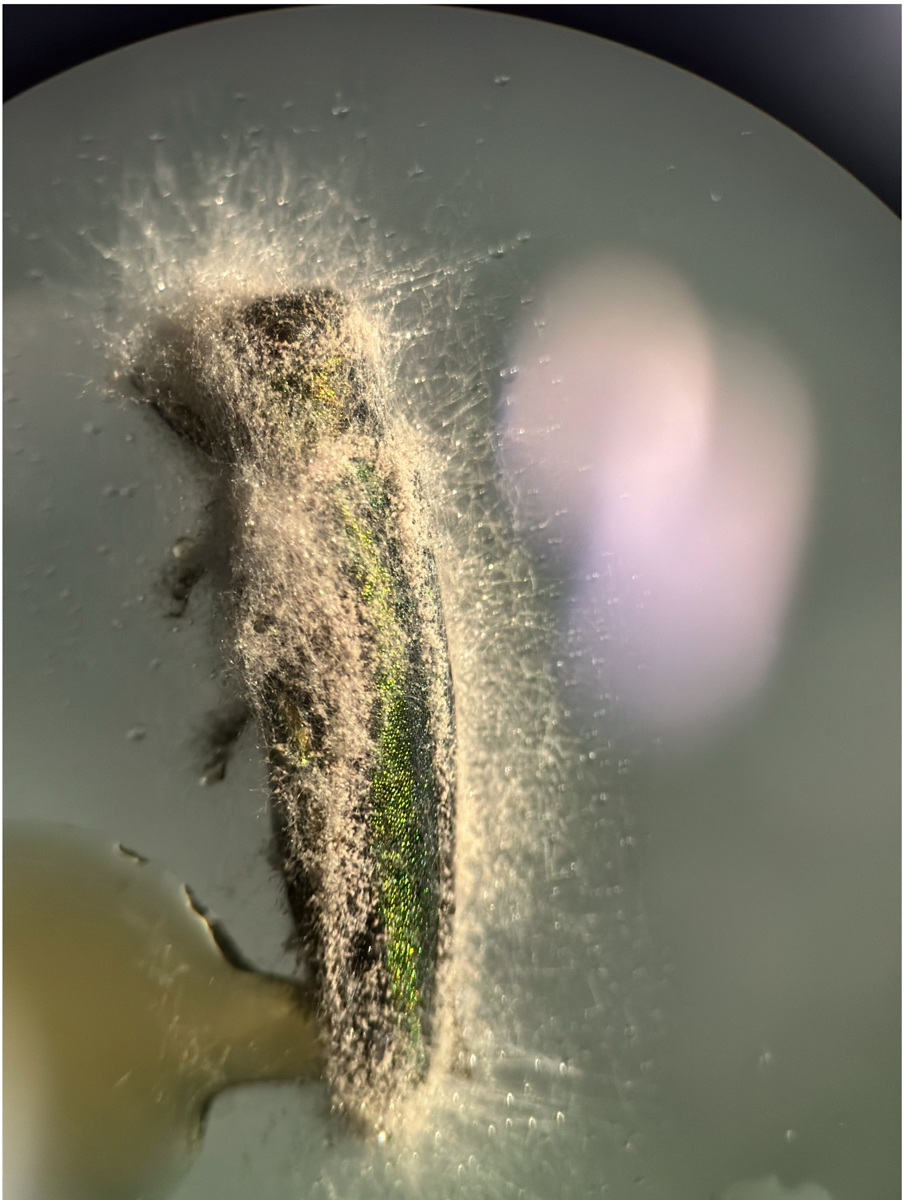
“In the lab, we have taken spores from each of our entomopathogens and applied them to EAB beetles, measuring which fungus is the most effective at killing the insect,” says Peters. “We have also investigated the field application of our fungi, trying various methods with preliminary promise.” Autodissemination devices are an exciting prospect, he says. These traps use pheromones to attract EAB and contain a live culture of fungus. Once inside the trap, the beetles are coated with fungal spores before they escape through an exit hole at the bottom.
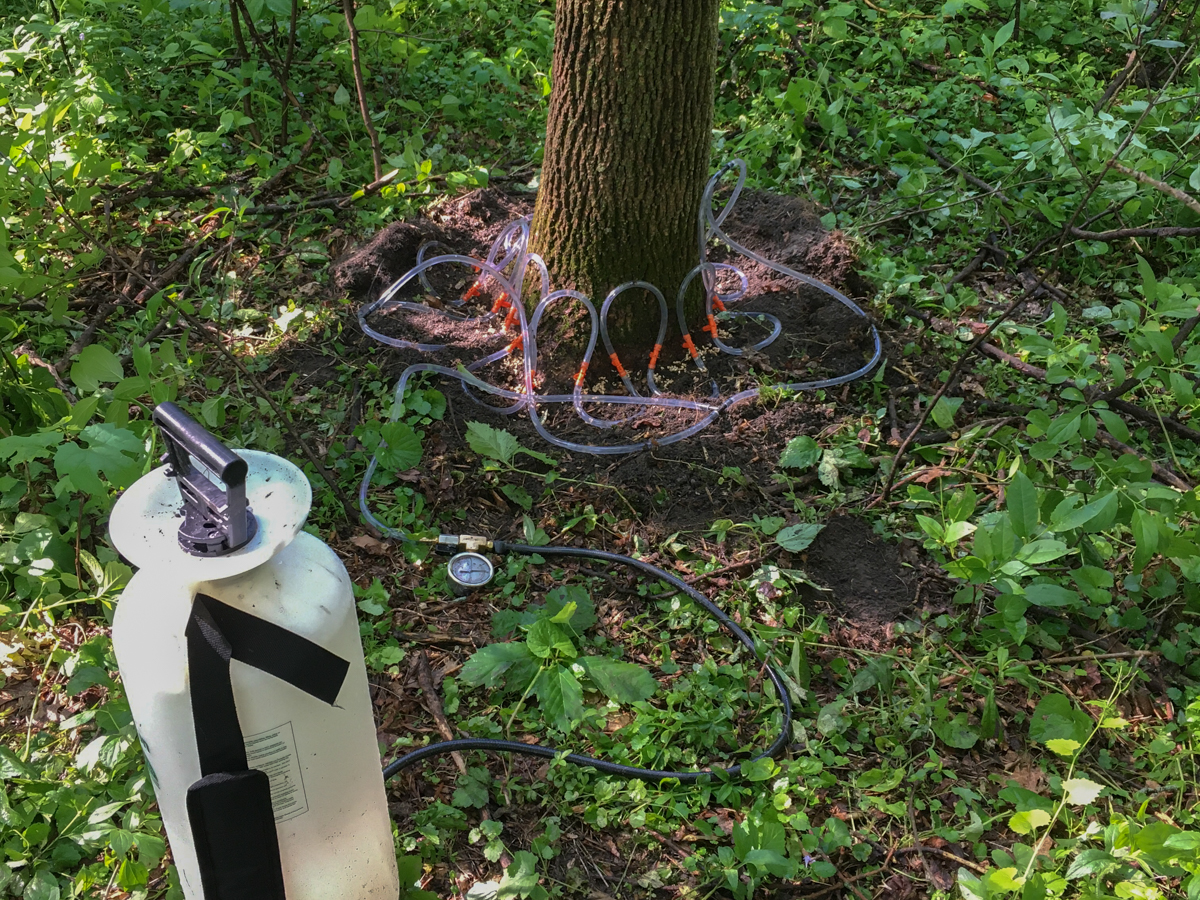
The team is also testing root flare injection. “Not only can these fungi kill insect pests, but they may be able to live harmlessly inside ash trees — we call these kinds of fungi endophytes,” Peters says. “The idea behind the injection method is to establish our fungus as an endophyte in an ash tree, so that once EAB tries to feed on the tree, it consumes the fungus and dies.”
Sustainable solutions
Immediate benefits of this research abound for managers in Minnesota and regions of North America where EAB is causing urban and forested tree loss. In contrast to chemical treatment, fungal biocontrols such as these may be environmentally sustainable, socially acceptable, and economically viable. “Right now, EAB management relies heavily on insecticides,” Peters says. Land managers and homeowners often inject trees every 2-3 years to provide protection. “While this has been effective in urban settings, imagine injecting a whole forest of ash trees — the number of technicians and dollars needed to do so would be staggering.”
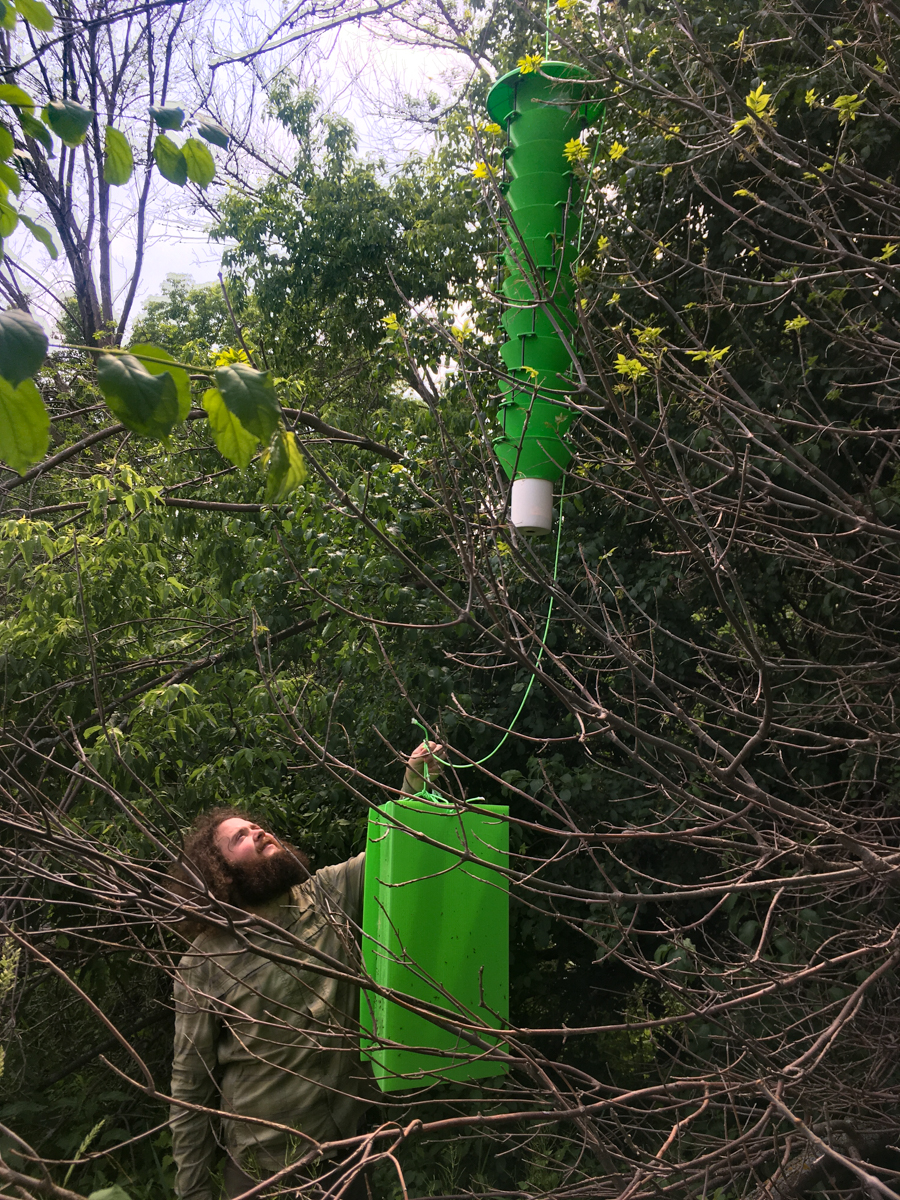
Fungal biocontrol could offer an alternative means of management in these forest settings for a relatively low cost in both labor and materials. “Autodissemination devices could potentially affect entire local populations of EAB,” adds Peters. “Once the beetles become infected with these fungi, they may further spread spores to one another through mating.”
However, forests are obviously more complex in their dynamics than lab studies can emulate. “No matter the scale of your research question, in a forest, there are always multiple players at work,” says Peters. “A fungus might be capable of killing EAB in the lab, but what about if there’s a severe drought in the woods? Or a cold snap? What about interactions with other fungi in the forest?” He says to help account for this, the team has been conducting field trials across various locations and over multiple years, to ensure their results translate to field settings.
“Slowing this beetle’s spread will require multiple management strategies,” Peters says. “Our fungal biocontrol would slow the spread of EAB in these natural settings where other management forms are less feasible.”
The Minnesota Invasive Terrestrial Plants and Pests Center is supported by the Environment and Natural Resources Trust Fund as recommended by the Legislative-Citizen Commission for Minnesota Resources.
Stay connected by signing up for the MITPPC newsletter. Follow us on LinkedIn and Facebook.
You may also like...
- Fungal biocontrol for emerald ash borer, research project
- Optimizing tree injections against emerald ash borer, research project
- Exploring public perception of emerald ash borer management, research project
- Using eDNA to identify presence of terrestrial invasive species, research project
- Fungi contribute to loss of structural strength in trees attacked by emerald ash borer
- Emerald ash borer management program, MN Department of Natural Resources
- Emerald ash borer in Minnesota, UMN Extension
- Emerald ash borer interactive map, MN Department of Agriculture